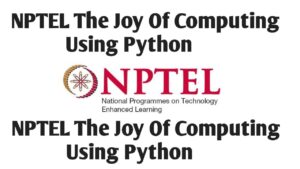Nptel The Joy of Computing Using Python Week 4 Assignment Answers
Searching for the Week 4 answers of the Nptel The Joy of Computing Using Python course? You’re in the right spot! Here, you’ll find reliable and up-to-date solutions to help you complete your Week 4 assignment with confidence.

The Joy of Computing using Python
ABOUT THE COURSE :
INTENDED AUDIENCE : Any interested audience
PREREQUISITES : 10th standard/high school
INDUSTRY SUPPORT : Every software company is aware of the potential of a first course in computer science. Especially of a first course in computing, done right.
COURSE LAYOUT – Click To Know More
- Motivation for Computing
- Welcome to Programming!!
- Variables and Expressions : Design your own calculator
- Loops and Conditionals : Hopscotch once again
- Lists, Tuples and Conditionals : Lets go on a trip
- Abstraction Everywhere : Apps in your phone
- Counting Candies : Crowd to the rescue
- Birthday Paradox : Find your twin
- Google Translate : Speak in any Language
- Currency Converter : Count your foreign trip expenses
- Monte Hall : 3 doors and a twist
- Sorting : Arrange the books
- Searching : Find in seconds
- Substitution Cipher : What’s the secret !!
- Sentiment Analysis : Analyse your Facebook data
- 20 questions game : I can read your mind
- Permutations : Jumbled Words
- Spot the similarities : Dobble game
- Count the words : Hundreds, Thousands or Millions.
- Rock, Paper and Scissor : Cheating not allowed !!
- Lie detector : No lies, only TRUTH
- Calculation of the Area : Don’t measure.
- Six degrees of separation : Meet your favourites
- Image Processing : Fun with images
- Tic tac toe : Let’s play
- Snakes and Ladders : Down the memory lane.
- Recursion : Tower of Hanoi
- Page Rank : How Google Works !!
Nptel The Joy of Computing Using Python Week 4 Assignment Answers
Q1. Which of the following options provides the general formula for the magic constant of a magic square of size n, where all elements are distinct numbers from 1 to n²?
a) n(n² + 1) / 2
b) n³ / 2
c) n³ + 2n²
d) (n⁴ + n²) / 2n
View Answer
Q2. What would the magic constant be for a magic square of size 7, given that all elements in the square are distinct numbers from 1 to 49?
a) 260
b) 111
c) 175
d) 165
View Answer
Q3. Does transposing any magic square change the sum across some rows/columns/diagonal?
a) Yes
b) No
View Answer
Q4. Which of the following are valid magic squares?
a)
10 5 4
15 3 16
9 6 12
7 8 11 14 1
b)
20 - e 10 - e 8 - e
30 - e 6 - e 32 - e
18 - e 12 - e 26 - e
4 - e 14 - e 24 - e
16 - e 22 - e 28 - 2e
2 - e
c)
18 13 12 14
11 2 7 4
5 16 9 15
10 3 6 1
d)
π8 π13 π12 π14
π11 π2 π7 π4
π5 π16 π9 π15
π10 π3 π6 π
View Answer
For Latest Update Join our official channel: Click here to join
Q5. What is the minimum number of people required to ensure that at least three of them share the same 30-minute birth interval? The intervals start from 12:00 AM, and each interval lasts for half an hour.
View Answer
Q6. Calculate the magic constant for a 5×5 square, where all elements are distinct numbers from 1 to 25. Is it the same as the magic constant for Ramanujan’s magic square?
If yes, enter 0, else enter the absolute difference between the two.
Hint: Search about Ramanujan’s magic square.
View Answer
Q7. What task does mystery1() perform?
a) Calculate factorial of number n.
b) Calculate factors of number n.
c) Calculate factors of number n+1 excluding n.
d) Calculate factors of number n excluding n.
View Answer
Q8. For what n1, n2 will the variable flag inside mystery2() be equal to True?
a) 1,2
b) 2,3
c) 3,4
d) 0,0
View Answer
For Latest Update Join our official channel: Click here to join
Q9. If all possible pairs of prime numbers between 0 and 10 are given to n1 and n2, for how many pairs would mystery2() print “Completed”?
a) It will print “Completed” only for pairs (2,3), (7,2), (2,5), and for the remaining it would not print “Completed”.
b) It will print “Completed” only for pair (2,3), and for the remaining other pairs of primes, it would not print “Completed”.
c) It will print “Completed” for all pairs of primes between 0 and 20.
d) It will not print “Completed” for any pair.
View Answer
Q10. If the number of pairs of primes that result in mystery2() printing “Completed” is lesser than 1, can we edit the code in mystery2() so that “Completed” is always printed for any pair of primes?
a) Yes, we can change the logic for setting the flag variable to False.
b) No, it is logically not possible.
c) Yes, we can change/decrease the threshold for the length of list2 in the last if block.
d) Yes, we can change the initial value of flag to False instead of True.
View Answer
Nptel The Joy Of Computing Using Python Week 5 Assignment Answers – Click Here